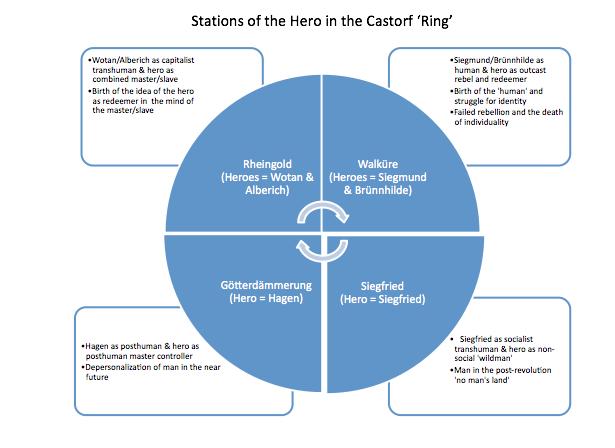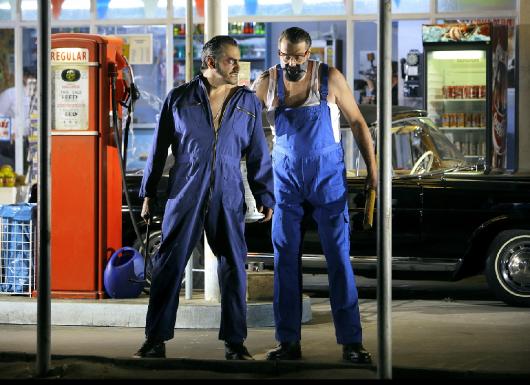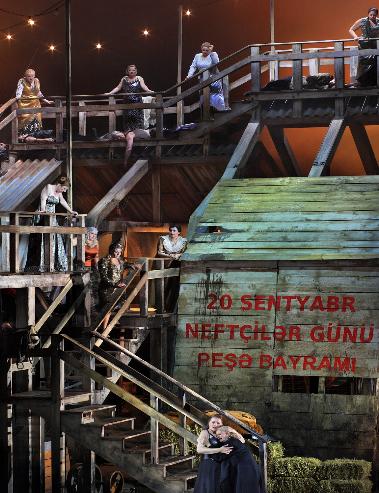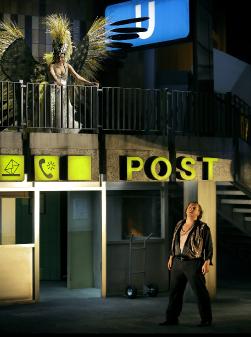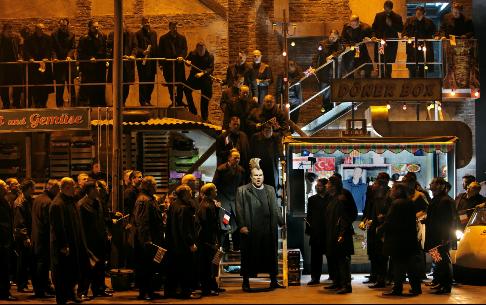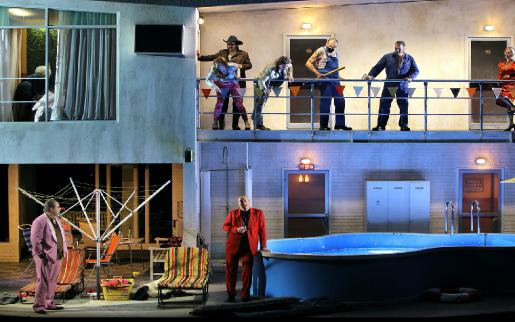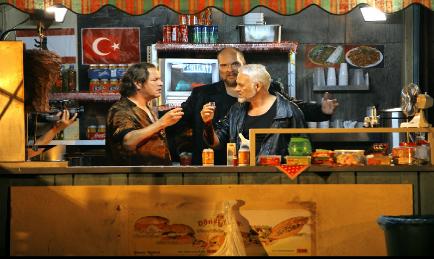 | |
II. OVERVIEW OF THE DRAMATURGY OF THE CASTORF 'RING' 1. The stations of the hero in the oil wars The underlying organising theme of the Castorf production has been clearly identified by the creative team in the programme book published by the Bayreuth theatre for the premiere season of this production in 2013 – the ‘gold’ which is the object of the conflict between the principals in Wagner’s original 19th-century scenography has been updated to our more recent past, present and future ages of personal and societal anxiety as the greed for power and political world dominance through competition to control oil-derived wealth and oil-driven technology.49Although an excellent starting-point, such as updating is not, in itself, sufficient to mark this as a landmark concept. The unique contribution of the direction of Frank Castorf, the dramaturgy of Patric Seibert and the associated stage installations of Aleksandar Denić derive from a recasting of the ‘Ring’ in the strikingly original deconstructed frame of postdramatic theatre – a uniquely bold recasting that facilitates a fluidity of expression and audience associations as free-flowing as the liquid ‘black gold’ itself. The overall plan of organisation is best presented diagrammatically and is summarised in the Figure below illustrating the ‘Stations of the Hero’ which drive the production. The cycle moves freely back and forth through capitalist, transitional/revolutionary and socialist phases of socio-political control reflecting the cyclic tension and transfer of power between these same forces on the 20th-century world stage. Within each phase, the definition of the societal ‘norm’, and with it the identification of the ‘hero’ in Wagner’s cosmology, transitions. Each phase, demarcated roughly as the province of each of the individual ‘Ring’ dramas, oozes/bleeds (literally and figuratively) naturally into its neighbouring phases around the circle/cycle, with each both presaging the next and recalling the prior in a manner that can only be adequately represented with the resonance-expanding devices unique to deconstruction-based theatre.
In ‘Rheingold’ we are introduced to Wotan/Alberich and the model of the hero in capitalist society as combined master and slave: both Valhalla and Nibelheim chiefs are the makers and breakers of laws, driven by their all- controlling and self-enslaving greed for power through ‘black gold’. The production sets ‘Rheingold’ close to our own era as exemplified by the materialistic excesses of the 1950s/1960s in the American centre of oil culture, Texas, on the modern mythic highway to freedom and adventure, Route 66.
A few words are in order on the critical concept of ‘transhumanism’ and the opposing concept, ‘posthumanism’, which will figure prominently in the rest of our discussion. In brief, the progression of transhumanism to posthumanism charts the increasing intersection over time of technology (i.e. oil dependency in the case of this production) with human functioning and both the positive and negative influence of that technology on the individual and on society. Man creates the technology but the technology also determines, for better or worse, human values and social constructs. This is the endless loop within the ‘Ring’ cycle and it reflects Wagner’s own misgivings about the effects on people and society of the industrial revolution in his own time as well as our own experience of the present biotechnology revolution. Transhuman states are interim stages on the post-industrial revolution continuum, with posthumanism being the near-future endpoint of the process, the beneficial or detrimental nature of which has been the topic of fierce debate since the turn of the 19th century to the present time.50 Contracts are easily made and even more readily broken in Castorf’s portrayal in ‘Rheingold’ of the American (and, more generally, Western) immediate post-World War II transhuman experience, as both the environment and human nature are subjugated in the mindless acquisition of the ‘bling’ that litters the stage in this production. At the final curtain, the birth of the hero as social reformer and redeemer is in the mind of both master–slaves, as represented by the late 1960s flower-children who gyrate in a drug-induced dance in response to the strong rhythm of the Entrance of the Gods into Valhalla which, in this context, appears like a Rock anthem for the coming revolution. ‘Die Walküre’ takes us backward in time to show us the dilemma of the only traditionally recognised pure hero in the cycle, Siegmund, at the dawn of the Age of Oil, circa late 1890s in the oil fields of Baku, Azerbaijan. This is the hero as outcast rebel and would-be redeemer, and it is initially the drama of the struggle for human identity exemplified by that hero.
Siegmund’s death represents the failed rebellions of 1848 in Wagner’s own time and the accompanying defeat of individuality and subjectivity which sets the stage for the socio-political upheavals of 1905 and 1917 in Russia – all of this clearly indicated by projections on screens above the stage and by images on the stage throughout this drama. The latter half of the opera, from the Act II, Scene 4 Annunciation of Death onwards, chronicles the emergence of Brünnhilde as a new, alternative model for the heroic and a symbol of the hope for a future humanity not obsessed by control for capital. This division of ‘Walküre’ into two intertwined stories, that of the law-breaking Volsungs and that of the law-making gods, is, of course, completely consistent with Wagner’s original plan of organisation of this drama, even though what Castorf does within this basic structure is highly novel. The Castorf staging also honours Wagner’s placement of the heart of the entire four-evening drama in Act II of ‘Walküre’ with Wotan’s monologue of self-awareness and resolution to destroy Siegmund. As Michael Steinberg summarises the central position of this episode: ‘The death of Siegmund at the hand of the self-entrapped father Wotan is a horrendous allegory for the destruction of subjectivity at the hand of a self-entrapped modernity, where rationality has produced not freedom but Weber’s iron cage.’51 The ensuing Ride of the Valkyries is literally the sound of the world coming apart at the seams, just as the Holländer in the earlier opera graphically foretold the world cracking open (‘Welt zusammenkracht’) at the Day of Judgment, and it is a chilling foretaste of the ‘Götterdämmerung’ to come. Siegfried is the next phase of this trajectory of the human in society and the station of the hero once rebellion has run its course and the will of the individual has been subjugated to the needs of the group. It is the transitional, transhuman, socialist phase (as opposed to the transhuman capitalist phase presented in ‘Rheingold’) and the Castorf/Denić team sets it against the backdrop of a parody of Mount Rushmore with the faces of the iconic American presidents replaced with the images of the equally iconic four founding fathers of Communism: Marx, Lenin, Stalin and Mao. Significantly, the Mount Rushmore parody set, whenever seen in these final two operas, is surrounded by scaffolding, both as a practical solution to providing more playing surface and to indicate that the socio-political system is forever a work in progress. We are reminded that the term, ‘political science’, has deep meaning in so much as all systems of government are, like biological natural selection, ultimately only experiments. Here too the Alexanderplatz in Cold War Berlin makes its first appearance (in Act II) as the great dividing line between the cultures of our modern East and West, just as the Neidhöle of Wagner’s poetic landscape represented the No Man’s Land of the sagas.
For Castorf, the Alexanderplatz is both the real and the modern mythic transitional zone marking the transition of power in our own time and socio-cultural and physical milieu for Siegfried, the product of this troubled and confused time, as he reaches the pivot point in his hero’s journey toward Brünnhilde. What manner of man is the new hero in this 20th-century time of troubles and transition? This alternative for the hero is the anti-social ‘Wildman’; he rejects human society rather than force-fitting into it. He is the unsocialised human isolated at a societal and philosophical crossroad, symbolised by the Alexanderplatz at the time of the Berlin Wall, in which the revolution is over, ‘God’ is dead, and a new order with new social norms for human interaction are yet to be fully established. It is ‘every man for himself’ in the No Man’s Land of the Cold War. Siegfried is the severely abused and developmentally stunted child Kaspar Hauser grown into an insecure, depressed and antisocial adolescent bully. As we point out elsewhere, the characterisation of Siegfried, in this Castorf production, as soul-murdered child/man akin to the famous historical Kaspar Hauser case from Wagner’s lifetime, is one that is entirely consistent with a presentation that modern psychiatry would find plausible, given the particular nature of his extreme abuse in childhood by Mime and given his genetic inheritance as deduced from our observations of the behaviour of his grandfather and the depressive nature of the father whom he never knew.52 Power passed to such a compromised individual can easily be taken away by others, as will be seen in the concluding drama of the cycle. The hope raised at the end of ‘Walküre’ for Brünnhilde as the new heroic model and the character who might break the cycle of dysfunction is dashed when she awakens at the end of ‘Siegfried’, much the same as she appeared in Act II of ‘Walküre’, uninterested in a larger role in the drama, and instead now so fixated on the achievement of domestic order through marriage that she ignores the many warning signals clearly given her that Siegfried is not the marrying type. Finally, in ‘Götterdämmerung’ we witness the rise of the hero of our near future, Hagen, and we recall that he is so identified in both the Nibelungenlied medieval source material and in Wagner’s libretto.
For Castorf, this is the posthuman hero as master controller in the coming age, as predicted by many, when man is in danger of being completely de-personalised and defined/controlled by the technology of his own creation. As in ‘Rheingold’, he is again both master and slave – we have come full circle in Wagner’s ‘Ring’, in Castorf’s presentation of the journey of the hero, and in our own evolution. It is a world in which societal structure is set and enforced as concretely as the grey heavy structures dominating the stage, and gratification once again as in ‘Rheingold’ comes through acquisition of objects of dubious real value and born out of oil money, like Gutrune’s prized Isetta or the Rhinemaiden’s luxury sedan. It is the pendulum swung full circle after the collapse of Soviet Communism, and similar to the prior capitalist social order but yet more extreme in reaction to past history and due to the multiplication over time of man’s technical prowess in producing objects. It is an amalgam of many cultures and socio-political systems, and the Gibichung mob in Act II waves the flags of multiple nations. We struggle to identify the national allegiance of these people, and we ultimately wonder if it really matters. There is now only the dim remembrance by the hero of the primordial pure pre-’Rheingold’ natural state, as evidenced by projections of Hagen plodding through forest glades during Siegfried’s Funeral Music. The final music drama as set in this posthuman collage of surrealistic New York Wall Street intermingled with modern German multicultural street scenes raises a critical question for the audience to consider: will the new posthuman hero reflect on his station and evolve? How will the cycle of the stations of man, the hero, be deconstructed in the future? Where do we go next? This ultimately was Wagner’s open question; it is equally Castorf’s and it continues to remain without resolution. Our final image at the end of the Castorf cycle is of Hagen broodily staring into the fires of destruction around him. As the closing chords of the orchestra sound a benediction over the proceedings, we can only hope that this is what he ponders. Therein alone lays our hope for humanity. 2. The operation of sheer forces Overarching this entire cyclic model across the four ‘Ring’ dramas there are three categories of sheer forces exerting pressure on the system, propelling movement through the phases of the story and affecting the characters caught in this web of their own (and our modern-day) history: characterological, socio-political and environmental sheer forces. We describe these axes next. Characterological The characterological axis embraces aspects or qualities of individual characters, including placement of the individual on the transhuman to posthuman continuum.53 This particular characterological dimension of transhumanism/posthumanism is very much time-period dependent (or, in the case of the Castorf ‘Ring’, individual opera-based). All of these characterological components make up the unique identity of persons – who we are, how we behave, what we feel, our drives and interests: our persona. As society values different characteristics of individuals over time, so does the concept of what is ‘heroic’ also morph. Socio-political The socio-political axis is a broad category of forces that have to do with how individuals are governed and organised into societies. This set of powerful sheer forces of the group range between the rule of consumerism that underpins capitalism, at one extreme, and the opposing societal organisational system of communal sharing of wealth under socialism, at the other extreme. In the Castorf ‘Ring’, as in the European realpolitik of the time, the post-World War II eastern bloc socialist system meets the western capitalist alternative in the socio-political pivot-point of the Alexanderplatz in Berlin. In this production, as in actual recent history, the Alexanderplatz will be the portal between alternative, imperfect worlds. It is both reality and mythic space: the socio-political battleground and the place where past, present and future most tangibly coexist. This all-important element of time, a component of the next axis, the environmental, is most palpably present here, and in a very real sense, Castorf fuses time into the physical space of the Alexanderplatz with all the resonances of that particular place for the socio-political context of the drama. This further serves to stimulate new associations for the audience as characters interact and in turn are developed (i.e. the characterological sheer forces), as they so often are, in this potent, twilight zone-like setting. It is a dramaturgical stroke of inspiration of a fittingly Wagnerian scale in its boldness and integrative power. Environmental The foregoing discussion of ‘time’ leads us naturally into a description of the last of the three sets of sheer forces operating in the production: the environmental axis. This refers to the physical environment outside the individual (i.e. the characterological) or the group (i.e. the socio-political) that impacts on both. It is the natural world context in which we all live and in which mankind, regardless of his stage of technological development, has always lived. The environmental sheer forces reveal nature harnessed/enslaved, like the oil forced out of the ground through a well, or freed to exhibit its power uninhibited, like the fiery destruction of that well in an explosion, both shown in ‘Walküre’. As previously indicated, time itself is one of these inexorable forces of nature, and the Castorf team incorporates and makes visible this critically important, but commonly overlooked, external environmental force in uniquely imaginative ways. Time is, ultimately, the frame for all deconstructions, in that as Derrida established, ‘iterability alters’, and nothing can be iterated unless time passes. Appropriately, Castorf gives time pride of place in his post-dramatic production of the ‘Ring’. 3. Deconstructive devices utilised throughout the production The unifying technique employed throughout this production is the use of irony to enable the exploration of alternative interpretations to the ‘Ring’ at both micro and macro levels. All commonly accepted principal categories of ironic expression – verbal, situational and dramatic – are employed as well as hybrid forms of irony such as Romantic irony. All these varieties capitalise on the variance between the prior conditioned expectations of an audience and their actual observations of what they are presented with during the performance at the deconstructive nodes identified within the work. The function of all forms of irony in a deconstruction-based production is to stimulate the audience–partner to recognise new associations and ultimately to consider new interpretations of the drama. This heavy reliance on irony is a characteristic of all post-dramatic theatre, and it was clearly identified as a key technique in the Castorf ‘Ring’ in the 2015 programme notes via the numerous quotations from the 1964 article ‘The Irony’ by Vladimir Jankélévitch, and by direct reference to this device by the production dramaturg and assistant director, Patric Seibert.54 In the service of enabling exposition, ironic or otherwise, in all parts of the cycle, five strategies/devices are consistently employed. All of these facilitate our ability to see and hear the work in a fresh perspective and, once again, to experience it as if for the first time. (Recall here Wagner’s plea down the corridors of time of ‘Kinder, macht Neues!’) Our detailed discussion later of the main images in the production in selected scenes will illustrate multiple specific examples of how each of these devices is used. These devices are: a) Liberal use of plastic or elastic objects as stage properties Plastic is a product of oil, and the ‘bling’ that litters the stage, particularly in the first and final operas of the cycle, to signify mindless materialism, is an ever-present reminder that the source of these trappings of affluence is itself an exploitation of the environment. The omnipresence of plastics and references to oil, oil exploration and petroleum-based industry is a potent visual leitmotif and a stand-in for the ‘gold’ in this concept. It also serves as the visual parallel to the musical structure of the ‘Ring’, which, like the overtly oil-based composition of the sets, is composed out of these fluid, malleable, ever-present and endlessly transforming building blocks of reminiscences which are the leitmotifs. The staging reflects the same principles of compositional organisation as does the music.
b) Insertion of a mime character into the drama Each of the music dramas in this production introduces a mime character actor who plays various roles – a gas station and convenience shop attendant in ‘Rheingold’, an oil field labourer in ‘Walküre’, a bear, a menial worker and a waiter in ‘Siegfried’, and a döner kebab stand owner in ‘Götterdämmerung’. As discussed earlier, mime is a highly suggestive form of expression in that it requires the audience actively to engage with the performer to interpret non-verbal behaviours and gestures, and this promotes consideration of alternatives of meaning. Thus, it fits very well into the present deconstruction-based production of the ‘Ring’. A mime does not tell you the story, as modern adult audiences have come to expect; instead, you piece it together as you understand it from his/her body language. Here again, the Castorf reliance on a device has clear Wagnerian lineage as Wagner was known greatly to value this very elemental, ‘plastic’ manner of expression, most evidenced, as already cited, by his well- documented admiration of the mimetic abilities of the American actor Joseph Jefferson on the London stage in ‘Rip Van Winkle’ in 1877, and we infer that the striking mime episodes for both Parsifal and Kundry in his final opera provide further support of his appreciation of this art form. In addition, it is very important to note that the production ‘architect’, Patric Seibert, portrays all of these mimed characters. This is significant in that the very presence onstage of the creative team colleague most responsible for the concept and assisting in the direction of the performance, is also interacting with Wagner’s prescribed characters as an integral part of the drama. This points up the drama as a construct and prompts the audience to question what belongs to the play and what is external to it; what is fiction and what is reality. In this manner, this particular mime actor is the very embodiment of Romantic irony. c) Use of prescience or foreshadowing Throughout this staging, images bombard us that connect the experienced ‘Ring’ audience member (as it is fair to assume describes all who attend the Bayreuth Festival) both backwards and forwards into the drama. There are numerous image frames in the production devoted to foreshadowing of events or character prescience, and we illustrate with just a few particularly striking examples: the (Russian) proletariat ‘bear’ of ‘Siegfried’ first appears as a bearskin rug at the end of ‘Walküre’ for the capitalist overlord, Wotan, to tread upon; the Russian Orthodox icon of St George the Dragon-slayer is the final image seen at curtain fall accompanying the Magic Fire Music of ‘Walküre’ and indicating that the hero of the future in the next drama will be a product of post-communist revolution Soviet culture; the Wanderer playing with a string during the prelude of Act III of ‘Siegfried’ presaging the rope of fate of the Norns in the next instalment of the drama; and Alberich and Mime appearing already bound at the start of the Nibelheim Scene in ‘Rheingold’, portending their ultimate fate in the cycle. On an even grander, macro scale, recognition that the ‘Rheingold’ staging, overall, represents a time period (i.e. 1960s America) very similar in appearance to that of the ‘futuristic’ ‘Götterdämmerung’ (i.e. c.1960s America and East Berlin), and that both are more recent than, certainly, the setting for ‘Walküre’ (c.1905 and 1917 Russian revolutions) and possibly that for ‘Siegfried’ (i.e. an indefinite Cold War period), reminds us that beginning and end are relative and a matter of perspective. It is interesting in this regard to recall that Wagner, in developing the prose sketch, did start his concept at the end, with ‘Siegfried’s Tod’, and then worked back to the beginning. Use of the device of foreshadowing or prescience, on either a micro or a macro level, compels us to accept the uncomfortable truth that we are in an infinite loop, a circle that has no beginning and no end; the end is embedded in the beginning and the beginning already includes the end. We are, both figuratively and literally, caught up in a ‘cycle’. Being compelled by this device continually to confront this continuity and inevitability of events constitutes a visual analogue to the operation of fate, a powerful force propelling the drama forward, and it serves to unify time and space in a manner that can disorient the audience and force reconsideration of events just seen, as well as provide a novel context for anticipation of those yet to occur. d) Omnipresence of video projections, cameras and film crew The production makes constant use of images within images as captured on film by a cameraman who is visible to the audience. These film sequences (i.e. how the camera ‘sees’ the action) are instantaneously projected either onto large-motion picture screens, as in ‘Rheingold’ Scenes 2 and 3, or on small television monitors, as in the Norns’ Scene and the Hall of the Gibichung set in Act I (i.e. the döner kebab stall, in this production) of ‘Götterdämmerung’. In this manner, the audience can choose which perspective to consider: that captured by the camera or the action as viewed ‘naturally’ as it unfolds ‘live’ on stage without the aid of selective camerawork.
This forces alternatives in perspective to be considered as the strategy presents the viewer with multiple, simultaneous, views of the same moment of action. An especially useful exposition of the effect of this technique appears in Tash Siddiqui’s 2014 review in The Wagner Journal in which she provides specific examples of how the screen detail often amplified her own experience of the drama.55 In this production, the audience must continually decide how and what they wish to see, as this device recurs regularly throughout the four evenings. Very importantly, this omnipresence of camera images and a film crew promotes our recognition of the Romantic irony that abounds throughout the ‘Ring’. We are presented with life observing itself and with the constant question before us of what is real and what is fiction; which is the true representation of the events on stage – that which we see directly ourselves or that which we see through the camera lens? e) Sets as portals and incorporation of anachronistic stage properties The stage installations of Aleksandar Denić are fluid, surrealistic ‘Alice in Wonderland’–like portals that allow a rapid cycling back and forth between locales and time periods. These are parallel universes – an apparent hommage to the immediately preceding ‘Ring’ at Bayreuth of Tankred Dorst – that become more inseparable as the drama progresses and the boundaries between eastern and western Cold War socio-political systems and their similarly destructive effects on the characters blur. Whereas the ‘Rheingold’ scenography, like its leitmotif structure, is relatively monochromatic (i.e. a seedy c.1960s motel along Route 66 in Texas), by the time we progress to ‘Götterdämmerung’ the stage picture, like the associated sound world, have become so complex and laden with multiple resonances that in the final act of the cycle a plastics factory, GDR apartment building, Turkish kebab and vegetable stall, Reichstag wrapped Christo-like, New York Stock Exchange and Mount Rushmore monument parody all appear in rapid succession on the rotating stage. The evolution of the scenography is, broadly, paralleling the evolution of the music, and both are illustrating a world increasingly out of control, with actions of characters, such as the murder of the kebab stall owner/mime actor followed by the bludgeoning to death of Siegfried, less and less anchored in reason. As the action grows more complex and rotates (both literally and figuratively) in and out of view, the increasingly dense scenography marked by this rapid cycling through time and space serves further to disorientate the audience and jolt it into recognition of new patterns of association in an attempt to restore balance. Wagner’s parable of mankind’s ever-growing dysfunction and breakdown of world order is ultimately a terrifying vision of human de-evolution, and the Castorf production, as aided by this device, gives the audience a taste of this directly through its own discomfort from the disorientation caused by the rapid cycling of stage images. Added to this manic fluidity of the stage picture is the frequent incorporation within scenes of anachronistic props, for example: Siegfried wields both Kalashnikov automatic rifle and sword, the mixed-period costuming of the Valkyries, and the presence of a bicycle as an escape vehicle for Siegmund, who has just recovered a weapon (i.e. sword) which is characteristic of an earlier era. This further intensifies resonances for a modern audience, draws attention once again to the relationship between time and space, and prompts new thought patterns about ‘meaning’. Acknowledging Wagner’s own expectation that he had created a living myth that needed to be recreated anew down the ages by audience-participants, equipped with a background of deconstruction-based postdramatic theatre, realising the concept of ‘stations of the hero’ underlying the Castorf production, recognising the sheer forces operating to move the production forward, and recalling the devices consistently utilised in the production to realise aims, we are ready to apply all of this knowledge in a detailed dissection of a selected key moment in the performance that we have not yet commented upon (except in passing) in the foregoing discussion of individual elements making up the concept: ‘Siegfried’ Act III, Scene 3. The awakening of Brünnhilde through to the end of the opera occupies approximately one hour of performance time at the epicentre of the tetralogy, and is one of the most challenging sequences in the entire cycle, as it is the point at which there is the first clear transition to a new order (i.e. ‘God’ is dead). The difficult to place ‘persona’ of Siegfried, as (now sexually awakened) adult protagonist, must be established, the reborn heroine needs to be defined, and the thorny matter of the hero ‘learning fear’ must be resolved. Truly, this is a momentous juncture in the epic and an acid test for any director. The approach of the Castorf team to this sequence illustrates their handling of the entire cycle, and therefore, although only a sample, serves as representative of the whole. Consistent with the Derridean tradition of the Castorf/Seibert/Denić achievement, we will not attempt to assign meaning – that is the responsibility and the privilege of each audience member who considers it from his or her own unique vantage point of person, time and place. It is the most democratic of all theatrical systems, and in that it is a fitting frame for the masterwork of this most democratic of masters. for continuation of article, click here
Return to Archive | |
